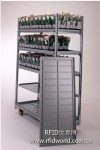
European horticultural logistics company CC uses active tags on carts
[ad_1]

The American branch of European horticultural logistics company Container Centralen (CC) is now installing active RFID tags on its 250,000 metal carts, enabling them to be tracked in 150 locations in the United States. This application involves the installation of RFID readers on remote farms, nurseries and greenhouses, said Sonny Costin, Chairman of Container Centralen. In this way, the company can know the location of the cart and the time of its transfer at any time, thereby increasing the utilization rate of the cart.
RF Code provides a stand-alone reader, Fluensee is responsible for the installation, and provides CC software for merging and analyzing RFID tags and reader data. Mitch Medford, president of RF Code, believes that once the system is officially launched in February 2010, this may be the largest active RFID tag application in the United States.
The cart is constructed of galvanized steel, approximately 53 inches wide, 22 inches deep, and 6.5 inches high. Each cart is placed on rubber wheels and contains 1-12 shelves. Container Centralen’s cart supply chain is very complex, and the cart tracking process requires barcode scanning and multiple Internet-based reports to update the cart location. Trolleys are usually shipped directly from the company’s warehouse (40 in the United States) to the grower, where the plants are loaded, and then shipped to a large retail store. After arriving at the retail store, the cart is used as a merchandise display stand.
Once all the plants in the cart are sold out, the cart is reused by the breeder or returned to the CC warehouse by a third-party logistics provider. Often companies may retrieve carts from multiple breeders and retailers. The breeder pays based on the use of the cart, so it is very important to track who and when the cart is used. Most of this information is obtained by workers scanning barcodes in warehouses and customer premises. Cart tracking is very important to CC-and very time consuming (e.g. using barcodes to identify large batches of carts). In addition, customers send cart information to CC via the Internet.
When the company started looking for a better cart tracking solution two years ago, it had to solve several problems: Many customers were in remote areas, and in some cases there was no network or power supply. Although CC uses passive RFID tags to track carts in Europe, this solution is not applicable to the United States. Costin claims that plant carts can pass through narrow entrances and exits in Europe and can be easily read by UHF RFID readers. Many breeders in the United States load trucks in large warehouses, and the wide doors prevent readers from automatically reading passive tags at such a wide distance.
The company began designing an active RFID solution with RF Code and Fluensee 18 months ago. RF Code labelled 20 carts, which were then shipped to an incubator in Texas. There, the cart is loaded with plants, and a local reader reads the tags.
Currently, Fluensee installs a 433 MHz tag between the bottom of each cart and the tire. The tag size is equivalent to two matchboxes. It uses a dedicated air protocol to send a unique ID code at a rate of once every two minutes. Fluensee also installs readers in 150 locations across the country. Of these, 40 belong to CC warehouses, Costin said, while the rest are the premises of the company’s customers.
CC plans to provide readers to every customer. However, some customers are very remote and lack electricity and internet. Under these circumstances, Medford said, RF Code developed a solar panel to power the device and a 3G modem to send data over the cellular phone network. “Most of the basic equipment is a single reader, including power and Ethernet connections,” Costin said, while the remaining locations may need to use modems and solar panels.
When the CC warehouse receives an order for a cart, the worker scans the bar code serial number of the cart, which corresponds to the data on the goods on the CC server. When the carts are shipped out of the warehouse, employees will not use the RFID system because the readers can easily acquire roaming signals-there are no cart tags that have been transported or transported elsewhere. Costin said that he hopes to use a handheld RFID reader to finally solve this problem, and is currently discussing a solution with RF Code.
After getting the cart, the customer delivers it to his location. There, the RFID reader will read the ID code of the tag, send the information to the CC server, and the Fluensee software will store the information to confirm that the cart has been received. The customer loads the plant in the cart, the cart is loaded onto the truck, and transported to the retail store, where the reader reads the tag; when the empty cart returns from the store, the tag is read again.
The last reading provided the most valuable information, Costin said, because CC can immediately update the information about which cart was used by which breeder. The Fluensee system can determine how long the cart stays in the retail store. In this way, the company can send trucks to the store to take the empty carts back to the warehouse to serve other customers.
The label costs about $10 and can be used for 7 years.
[ad_2]


